
Siyuan Huang
COSMOS 2024
Cluster 5

Robotics

MindStorm Robots
- Started by building robot with Legos
- Wrote code in C language on MindStorm robot application for robot to do tasks
- Learned the basics of an operating system through connection of robot to computer
- Learned about robotics in real world phenomena:
- Friction, sliding, etc.
- Learned to write flow charts before coding
- Learned to apply math to robotics
- Used angle measurement to make robot go in a star


Final Project (initial)
- Create two robots
- one that flips pages of a book
- takes book and places it on the other robot
- Use sensors like infrared, sound, and ultrasonic to detect surroundings
- drew initial design
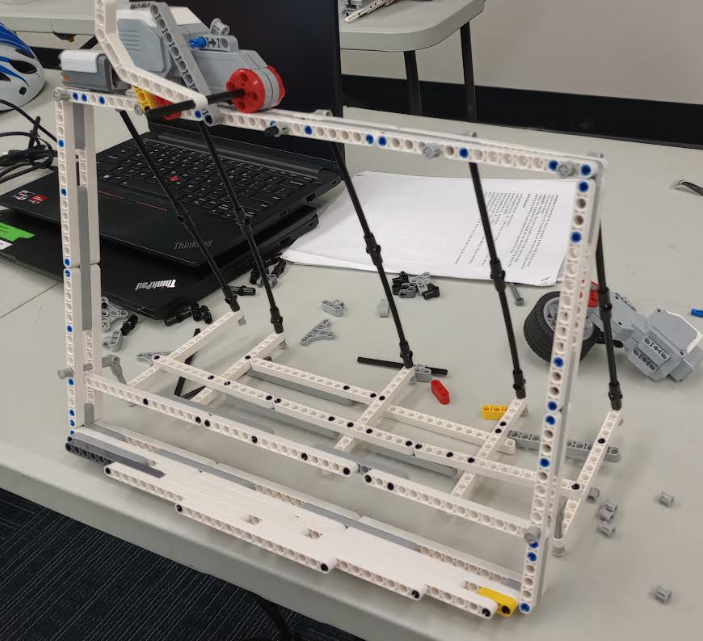

Final Project (progress)
- Creating a sound activated device that flips pages when user claps or says “turn”
- Used mic, gears, motors, sound sensors, and control boards
- Wrote code on computer and imported to robot
- Took input as a loud noise (sound)
- Problems faced:
- Robot kept activating and turning the page when no one clapped
- Figured out that we put threshold too low and was picking up on background noises


Final Project
- Page flipper robot that flips pages when user claps or says “turn”
- Book sensor robot that is able to find the nearest book , go to it, and make a loud beep sound
- Music follower robot that listens to its surroundings and follows music played by the user
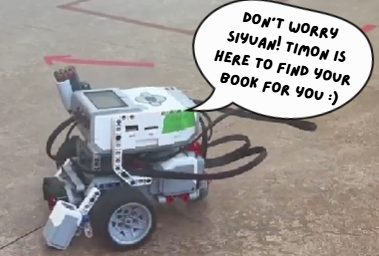
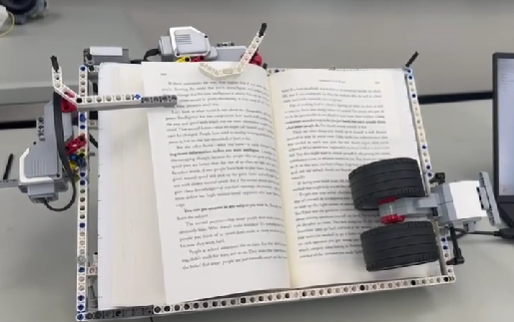

BioPhysics

Bioinformatics

- Bioinformatics (Python)
- Computer tech to collect, store, and analyze biological data like DNA and amino acids
- Used code to convert DNA to RNA
- Learned about RNA codes that translate to amino acids and how they can be identified in a strand of RNA
- DNA and RNA: four letters
- Amino acids: 20 letter codes

Gambler’s Ruin
- Simulated the probability that one will win
- Created simulations to find probability that one event would occur and how pre-conditions affect the final probability
- Used mathematics to prove probability
- Learned mathematical solution to Gambler’s Ruin simulation
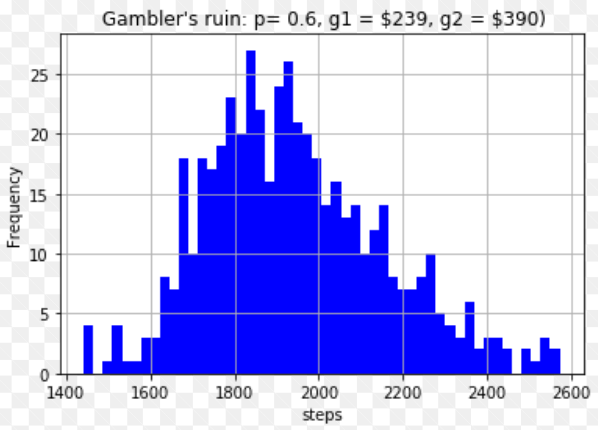

1D Random Walk
- Bias walk by giving it greater possibility to go in a direction or by giving it a different starting point
- Learned to find average distance from start by using equation: sqrt(<x^2>) where x represents final position
- Learned diffusion theory
- Ran simulation to test theory and plotted results to compare
- Found relationship between average distance from start and number of steps taken found that it is sqrt function; square root function
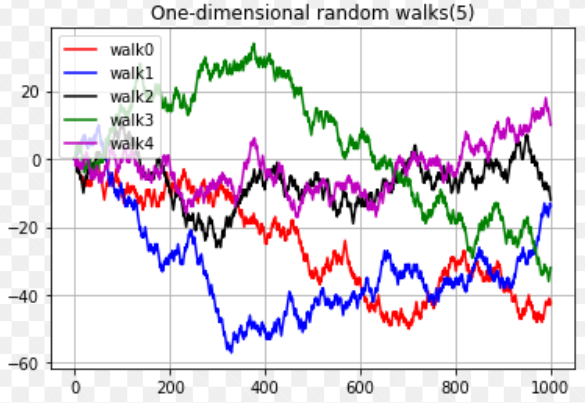

2D Random Walk
- Cartesian coordinates: random steps
- Polar coordinate: random angles
- Simulated 2D random walk with random grid functions and random angles functions
- Steps: all coordinates to left, right, up and down
- Angles: 0 to 2pi and use trig to generate random coordinates for the walk


2D Random Walk With Target
- 2D random walk with target:
- Add target within boundary that random walker is looking for
- when target is reached, random walk stops
- Molecules (mRNA) can be used (at ribosome where mRNA becomes template for protein)
- graphed histogram with frequency and steps taken to get to target
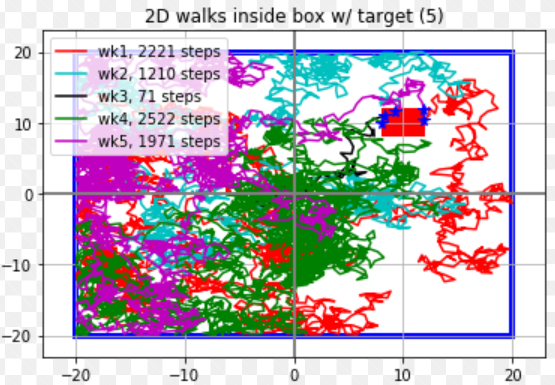

Final Project
- 3D Random Walks
- Use spherical coordinates to conduct random walk
- X = p(sinxcosx)
- Y = p(sinxsiny)
- Z = p(cosx)
- P = sqrt(x^2+y^2+z^2)
- Using graph [position of walker over number of steps] for both 2D and 3D to prove that 2D always returns to the origin while 3D does not
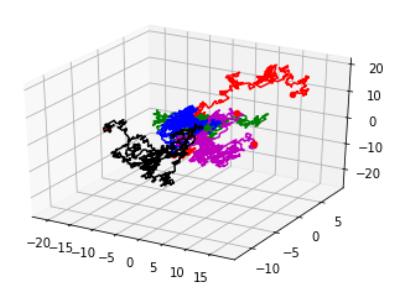
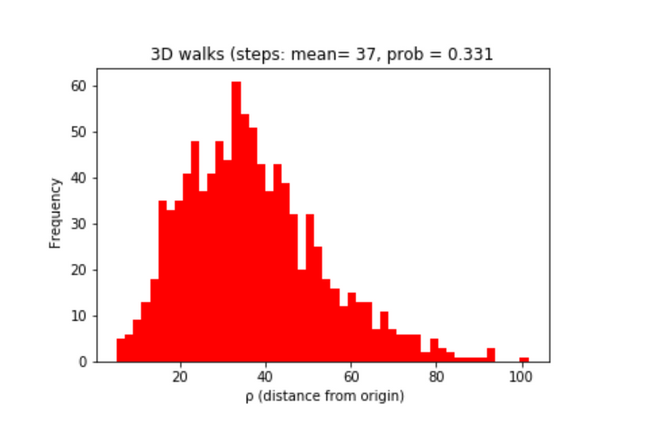

Daily Journal
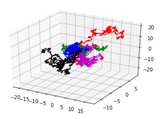

Journal (7/8/24):
I have 128 GB memory in my phone. Memory is what a computer can store for a while, but storage is what is saved for a long time. Directions and code both must have a clear indicator of beginning and end; code uses curly brackets while directions use words. And, both code and directions are written in order of how they should be followed.
The most challenging aspect so far at COSMOS is memorizing the directions to go to class, dorms, and the dining hall. I do not have a bike so I have to walk everywhere, which gets very tiring sometimes. That is why I have to bring a water bottle every day and sunscreen as well.
Journal (7/9/24)
Physical robots act in the real world where not everything will go as planned. For example, friction, sliding, and other outside aspects will cause the robot to operate out of place. I wrote code for the robot to move in a straight line for 3 seconds and stop. But it took time for the robot to actually stop because of the smooth surface and the speed at which my robot was going. I had to adjust my code according to real world phenomena. My experience working with LINUX was fun at times but frustrating at others. I have to take into account all of the different errors that may occur when the robot runs, so it gets really annoying sometimes. But after fixing the code, the feeling of having a working robot is very satisfactory.
I think I have a good balance of learning and having fun. I think every time I write new code for the robot to run, it is learning about mechanics in real world applications, but also having fun with creating and innovating. I do not think that I need to have a “better perspective” of this work-life balance because I think I am adapting to this new style of hands-on learning very well.
Journal (7/10/24)
I will write about my challenging experiences in high school and how that shaped me into the person I am now. I will also write about the ways I have impacted my community through community services like teaching students STEM. Additionally, I will outline the aspirations that I aim to accomplish in the college of my choice.
(look at instructions) → (pull up sample code) → (rewrite code for robot to perform task) → (download code) → (try on robot) → (fix code)
Each time I test, even when frustrating, I am presented with valuable learning opportunities. Failures and errors were not just obstacles but important feedback that helped me improve. Learning from these moments are essential parts of the learning process that helped me grow stronger and more capable.
Journal (7/11/24)
The coding activities today were more fun than the ones yesterday because I got to use some cool sensors for my robot. I did two activities with the touch and sound sensor, which were very interesting as I got to run my code and see it work in real time. The coding was not as difficult, but still quite frustrating. I still have to fix a lot of the errors, but learning from my previous mistakes made the progress easier. I think the pace right now is perfect and I do not want us to go faster or slower.
To deal with the frustrations, I always ask other people how they feel about their project and work with them to fix my code. Working together really helps alleviate the frustration of not being able to accomplish something after many tries. To deal with the frustration in a more positive way, I will ask the teacher questions if I am really stuck on a piece of code.
Journal (7/12/24):
I think we will most likely have trouble designing the wheel that turns the page of the book, which our robot is designed to do. The pros of Python is that it is extremely easy to learn and write since a lot of the methods are already implemented. However, C is definitely faster to run than Python.
Journal (7/16):
I think we start with Gambler’s Ruin because it is a perfect example of simulation in predicting the probability that something would happen. I believe it is an interesting choice since I get to do some hands-on activities instead of just looking at simulations.
I walk quite a lot to class every day so I think I do have regular exercise. I now developed a good habit of eating on time and not pushing away food.
Journal (7/17)
Mathematical logic is used in programming conditional statements that are code to make the robot complete its task.
I hope to see some behind the scenes of science and implementation of programming in big science projects.

Journal (7/23/24):
Today at the Exploratorium, my friend and I walked around and saw many interesting exhibits like art, psychology, and physics. We got to do some hands-on activities with gear, motors, and magnets to help us better understand mechanical engineering and its application in the real world. One of my personal favorite exhibits is the “differential“ exhibit. We learned that a differential lets two connected wheels turn at different speeds. And how does this work? The drive wheels on a car are linked together so that a single engine and driveshaft can turn both wheels. As long as someone drives straight, both wheels turn at the same speed. But when turning, the outer wheel has to be faster than the inner wheel, a phenomenon we experimented with on the Lego MindStorm robots, The gears of a differential allows this to happen. For the hands on activity, I held one of the two wheels to slow and then stopped it. I noticed that the fear of the second robot turned faster as the first wheel slowed down. I also noticed that it was not possible to slow down or stop both gears at the same time. This could be very useful in the creation of my book retriever robot which would need to utilize gears to make turns around objects.
Journal (7/22)
Some logical statements that are very useful are the “and” and “or” statements since making a robot definitely requires many scenarios.
I think we have enough time to finish our robot before the deadline, but we do need to film the demonstration video and edit it before Friday, which is going to be quite difficult.
Journal (7/25)
Today I learned that these DMG MORI robots can make things big and small; motor parts and small gears.
In UC Davis I learned to wash my clothes.
Journal (7/29)
- We just started on our biophysics project and finished researching all the things needed for it.
- We are almost done coding the robots.
- I am currently updating the website.